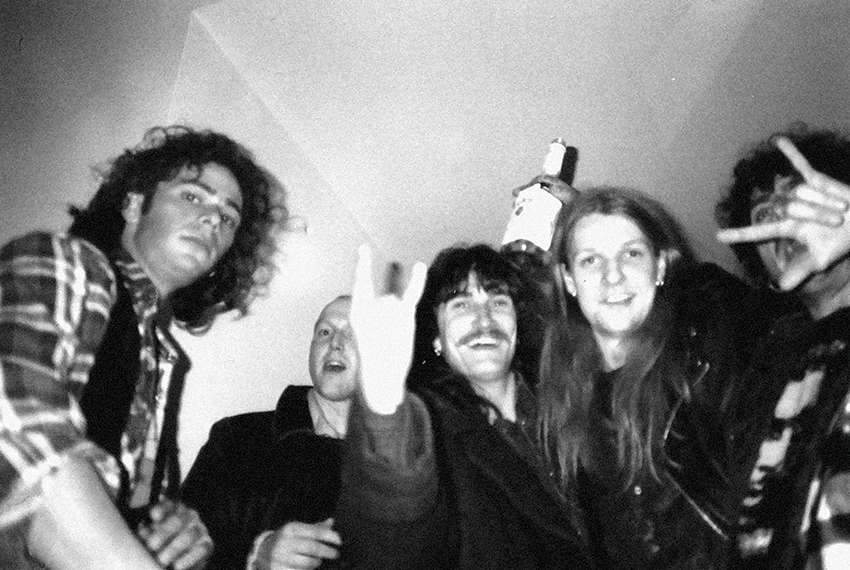
To celebrate the official release of Amorphis: The Official Story of Finland’s Greatest Metal Band, Decibel is proud to share the first excerpt from this limited edition, 376-page hardcover book authored by longtime Finnish journalist Markus Laakso. The following passage takes readers back to 1993, shortly after the completion of Amorphis’ legendary, Decibel Hall of Fame-inducted sophomore LP, Tales from the Thousand Lakes.

When Amorphis finished The Karelian Isthmus the band members were happy that their old songs were finally available to hear, instead of gathering dust on rehearsal tapes. Their artistic image, however, still hadn’t fully developed into a distinctive one. The starting point for Tales from the Thousand Lakes was completely different. Everything felt fresh because the songs now represented exactly what the members wanted. After all, they were fans of prog and folk music yet with their roots in death metal. The album was an extension of their personalities. And most importantly: their new melody-rich style was born naturally, without forcing anything or anyone. It felt fabulous.
It felt right.
“I can still remember the feeling when I came home from Sweden with that cassette,” says guitarist Tomi “Koippari” Koivusaari. “A few friends came to visit, some of whom are still tagging along as our merch people. We had a few beers and played the tape. Oh, man, it sounded good. I was pretty stoked.”
“I felt confident about Tales,” describes bassist Olli-Pekka “Oppu” Laine. “We knew we had made a damn good record. I was really digging it myself when I listened to it. Koippari and I might call each other in the middle of the night, saying ‘goddamn, this album is great—I just listened to it again!’ So, yes, we were sincerely proud of it. It was just the kind of music what we wanted to make and listen to ourselves.”
Relapse, too, sensed the album’s potential and wanted to invest in marketing it properly. The label simultaneously began pressuring Amorphis into signing a new record deal that would annul the previous three-album deal they had. The new deal consisted of Tales from the Thousand Lakes as well as a label option for four full-length albums after that. The 18-page stack of papers was tedious to read and full of legalese. It came along with a five-page publishing contract that would take half of the songwriters’ royalties. Because publishing rights couldn’t be given up freely according to U.S. law, the label asked for one U.S. dollar as their price.
“Relapse began blackmailing us after they got the Tales master in their hands,” Oppu reflects. “They said that the album won’t be available in stores until we have signed the papers. I guess they thought the first deal was too generous.”
Although the band only wanted to get their album out and wasn’t interested in the business side of things, they didn’t agree to sign the deal—that felt too reckless. Instead, they asked for professional advice first. However, for a Finnish artist to have a record deal with an American record company was such a rarity that there really weren’t many specialists available in Finland.
“There was one place in Helsinki where we could have had the deal papers translated,” says Koivusaari,” but it would have cost 20,000 Finnish marks. We didn’t go with that. Out of the kindness of their hearts, Kari Hynninen and the then-chairman of the Finnish performance rights organization Teosto, Otto Donner, checked the papers out and pointed out a few parts that ought to be changed. No one knew anything about Seppo Vesterinen [manager of e.g. Hanoi Rocks and HIM] at the time. He had vanished to be a gardener somewhere.”
Despite fax machines, communicating across continents was slow, so Amorphis managed to defer signing the deal for a good while. Relapse in turn wasn’t in a hurry to release the album: the record was finished in September 1993, and it came out nearly a year later, July 12, 1994. The album was leaked to the tape trading network several months before its official release date. It disappeared from a party held at the vegetable factory, and soon made its way into the hands of the scene’s most active participants. The fidelity of the cassette copy wasn’t on par with CD quality, so the underground still eagerly awaited the album. In the band’s opinion, the leak was actually more beneficial than detrimental.
Before Tales made its way to store shelves, Relapse published—without asking the band’s permission—the songs recorded in 1991 for the Incantation split as an EP called Privilege of Evil, released on December 5, 1993. This angered the musicians because some fans bought this mini album thinking it was as a brand new recording. Artistically, the band was headed in the opposite direction away from brutal death metal. The cover art irritated them, too. The black and white piece was a more stylized version of the “sausage seller picture” from their Disment of Soul demo.

“The EP was released at a ridiculous time and with no mention that it was already old,” Koivusaari says resentfully. “It was a totally senseless thing to do. Every one of us was already digging a totally different kind of music, and I was in the middle of some weird hippie phase. Even at gigs I was wearing a pair of orange, bootcut velvet pants, a checkered shirt hanging open with a Doors T-shirt underneath it.”
While the band’s music developed into a more folk-influenced, melodic, and progressive direction, Privilege of Evil was even more raw than The Karelian Isthmus in terms of playing, production, and arrangements. It represented all the elements that the band wanted to bury. To top it all off, guitarist Esa Holopainen’s parents’ postal address was printed on the back cover. As a result, Amorphis fans from Germany started appearing at their door in the hopes of getting an autograph, a photo together, or a chance to chat with the artists. Esa already moved into his own place, which made the situation even more awkward for all parties.
The relationship between the band and their label was further strained by how, due to their new deal, Amorphis gave Relapse decision-making authority regarding the album’s song order and final track selection. Relapse then decided to leave three songs off Tales from the Thousand Lakes, to arrange the songs in a completely different order than what the band had planned, and to release the discarded songs later as the EP Black Winter Day. In addition to its title track, the EP consisted of an instrumental called “Folk of the North,” which lasted one and half minutes; “Moon and Sun,” featuring some hues from The Karelian Isthmus; and “Moon and Sun Part II: North’s Son,” which delivered plenty of melodies, each one catchier than the last.
After hearing Tales, Nuclear Blast began to show greater interest in Amorphis. At the time of The Karelian Isthmus, Relapse made a two-way distribution and licensing deal with the German company, which meant that Nuclear Blast released all Relapse albums in Europe and Relapse released all “Nuke” albums in North America. After this, Amorphis was mainly in contact with Nuclear Blast—especially since the messages to and from Relapse turned quite pointed. Thanks to their growing relationship with Nuclear Blast, the band’s media attention and popularity quickly reached a new level.
Nuclear Blast flew Amorphis to Germany for a weekend to shoot two music videos prior to the album’s release. The label hired Matt Vein as the director, and he showed up at the airport to pick up the musicians who enjoyed the free inflight servings of alcohol. When the director began sharing his visions about the plot for “Black Winter Day,” the musicians fell silent.
“The script of the video was that a little girl goes to the dentist and falls into a trance in the dentist’s chair,” laughs Holopainen. “She then wakes up in the forest where she meets a witch and ends up in the middle of a Medieval ball. We were asking each other, ‘did you hear the same thing I did?’ We started suggesting if falling into a trance might perhaps take place in some other way than at the dentist.”
The director didn’t receive the critique well, but kept insisting that his idea would work. The parties agreed on a compromise: the idea with the dentist was abandoned but the child and the Medieval ball would remain.
Vein accommodated the band at his home and personally spent the night elsewhere. As he was about to leave, he mentioned there were some clothes upstairs for each member to pick from and wear whatever they wished for the shoot. The musicians, however, already decided they wouldn’t be wearing any weird gear, so the piles of ruffly clothes the director gathered caused both horrified and amused reactions.
“It was a relaxed evening,” says Koivusaari, amused. “Esa acted as the model: He went upstairs to put on some clothes, came downstairs, and everyone else laughed their asses off.”
Vein arrived home early in the morning. His shock was great when the clothes for the shoot were spread all around the apartment. Next, he was surprised to learn the band wasn’t going to be wearing any of them for the shoot.
On location, all sorts of weird people were on the set. The driver for the band seemed to be buzzed from alcohol and who knows what else. His arm was bandaged and he had an angry little terrier with him.
“We were wondering what would be more worrisome,” Koivusaari says, “if the guy had his hand in a bandage because his dog had mauled him, or because he’s had a car accident while being drunk or stoned. Every time Kasper tried to put on his seatbelt, the dog snarled.”
They spent the entire night shooting the weird clip. Aesthetically, the video in no way represented the national romantic Kalevala style the band highlighted. Their workload of filming continued the next day by shooting the promotional video for “Into Hiding.” The song was planned to be the first single from the album, but because the shoot turned out into an even greater farce than “Black Winter Day,” the idea was abandoned.
“’Into Hiding’ was a video about a school rebellion, and the director chose Oppu as the main character. Oppu’s character was someone who’d been kicked and bullied at school. He was supposed to fill the entire chalkboard, writing, ‘Into Hiding, Into Hiding, Into Hiding…’ At times, they filmed him lying down between the poles of a soccer goal. And then we’re in the classroom, throwing desks around. Oh man,” Holopainen says, shaking his head.
The plot made no sense and the video also looked amateurish. It was a collage of elements chronicling, in a caricature-like manner, a problematic educational institution. Its storyline featured—but was not limited to—a man driving a motorcycle down the school’s corridor; a runaway tarantula; a boy on a skateboard; a burning dustbin; school desks being thrown in a classroom; and a metal band—Amorphis—performing to a pupil audience. To top it all off, some of the assistants hired as pupils looked like they were 30.
When the video was finished the band made Nuclear Blast promise it would never be made public. The record company agreed, but in the early 2010s this shoddy creation—something the record label folks still entertain themselves with at their company Christmas parties—inexplicably appeared on YouTube.
“We had been in talks about releasing the video as part of our Forging the Land of the Thousand Lakes DVD (2010),” Koivusaari says. “Some of our members even demanded it—but we kept the promise we had made with Esa and Oppu to never release it. We also told the record company that the video simply doesn’t exist, if you get my gist,” he continues.
The band’s promo shoot for their album booklet took place on the morning after a boozy two-day video session. The tiredness and hungover appearance are especially noticeable on Oppu’s face. Even though the video shoot wasn’t quite a success, “Black Winter Day” was received enthusiastically by MTV’s Headbangers Ball, which put the video in rotation. It was one of the first—if not indeed the first—Finnish metal music videos shown on the channel. That honor was a big deal even for the Amorphis guys who watched the show. They had reached another small milestone.
In North America, order a copy of the Decibel Books hardcover of Amorphis: The Official Story of Finland’s Greatest Metal Band right here.
In Europe, order a copy of the Svart Records hardcover Amorphis here.






